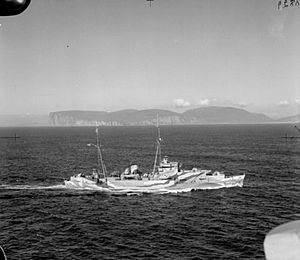HMS Palomares facts for kids
class="infobox " style="float: right; clear: right; width: 315px; border-spacing: 2px; text-align: left; font-size: 90%;"
| colspan="2" style="text-align: center; font-size: 90%; line-height: 1.5em;" | 
|} HMS Palomares was a special British ship used during World War II. It started as a regular cargo ship before being changed into a warship.
The ship was first called MV Palomares. It was built in 1937 by William Doxford & Sons in Sunderland. It was a fast ship, known as a "banana boat," because it carried fruit. It could travel at 13.5 knots (about 25 kilometers per hour). In January 1938, it began working for the MacAndrews Line, carrying goods to Spain.
Contents
| History | |
|---|---|
| Name | MV Palomares |
| Operator | MacAndrews Line |
| Builder | William Doxford & Sons, Sunderland |
| Launched | 20 October 1937 |
| Out of service | 1940 |
| Fate | Sold |
| Name | HMS Palomares |
| Owner | Royal Navy |
| Acquired | 1940 |
| Identification | Pennant number: F98 |
| Fate | Sold |
| Name | MV Palomares |
| Operator | MacAndrews Line |
| Fate | Sold 1959, wrecked 1961 |
| General characteristics as HMS Palomares | |
| Tonnage | 1,896 GRT |
| Armament | 4x2 4-inch guns, 2x4 2-pdr guns |
Life as a Warship
The British Navy bought the Palomares in 1940. They liked that it was fast and easy to steer. In 1941, they changed it into an Anti-Aircraft Artillery ship. This meant it was fitted with powerful guns to shoot down enemy planes. Later, it became a Fighter Direction Ship. This type of ship helped guide friendly fighter planes using radar. Its sister ship, HMS Pozarica, was also converted.
Joining Convoys and Operations
In March 1942, Palomares sailed with Pozarica and several smaller warships called corvettes. They traveled to Seyðisfjörður in Iceland.
In June 1942, Palomares helped protect Convoy PQ 17. This was a group of ships sailing to Murmansk and Archangel in Russia. Sadly, 25 out of 36 ships in the convoy were lost to enemy attacks.
In November 1942, HMS Palomares took part in Operation Torch. This was when Allied forces landed in Algiers, North Africa. Palomares acted as an Anti-Aircraft ship, protecting the landing forces. On November 9, the ship was hit by a bomb. It caught fire, and its steering system was damaged. The crew worked quickly, and the steering was fixed by November 10.
Directing Fighters in Italy
In September 1943, Palomares was a Fighter Direction ship during the Salerno landings in Italy. It used its radar to guide fighter planes to their targets.
In January 1944, Palomares again served as a Fighter Direction ship during the Anzio landings. It arrived on January 22. However, it hit an underwater mine. The tugboats Edenshaw and Evea had to tow it back to Naples for repairs.
In September 1945, Palomares was supposed to help with landings in Malaya. But a fire in its engine room stopped it from taking part.
Ship's Features
When HMS Palomares became an Anti-Aircraft ship, it got some serious firepower. It was armed with eight 4-inch anti-aircraft guns. These were set up in four turrets (spinning gun platforms). It also had eight 2-pounder (40mm) anti-aircraft guns. These were in two mounts, each holding four guns.
In December 1942, to become a fighter-direction ship, Palomares was fitted with radar. This special equipment helped it find and direct fighter aircraft.
HMS Palomares weighed 1,896 tons. It could travel at a speed of 13.5 knots, which was quite fast for a ship of its size.
After the War
HMS Palomares survived the war. In 1946, it was given back to the MacAndrews Line, its original owners. It continued to work as a cargo ship until 1959.
After that, it was sold and renamed Mary Sven. In 1961, it was sold again and became Sarabande. On October 5, 1961, a fire broke out on board. The ship then drifted onto the shore and was wrecked.

